Stay updated with the latest - Click here to follow us on Instagram
China unveils new aircraft carrier: How does it compare against the competition?
The dragon is moving with pace in the race to upgrade and upscale its naval force. Here’s a look at the new Chinese carrier and how it stacks up against the most formidable carriers of some of the strongest navies in the world.
 China’s indigenous aircraft carrier provisionally called Type 001A will go to a two-year sea trial before inducted into full-time service.
China’s indigenous aircraft carrier provisionally called Type 001A will go to a two-year sea trial before inducted into full-time service.
China launched its second aircraft carrier on Tuesday with pomp and celebration. The carrier hasn’t been christened yet and is being provisionally called Type 001A. The dragon is moving with pace in the race to upgrade and upscale its naval force. Here’s a look at the new Chinese carrier and how it stacks up against the most formidable carriers of some of the strongest navies in the world.
Chinese “Blue Water” program for the Navy whose force projection could extend beyond its waters, could serve its global strategic interests. Its aircraft carrier program is central to that program. The country has a carrier already active in service and the new carrier will go to a minimum two-year sea trial before being pulled into full active service. Modernising the Chinese People’s Liberation Army has been central to President Xi Jinping’s plans since he assumed power in 2012. The inauguration of the carrier was done in the backdrop of US deployment of a naval strike group led by aircraft carrier USS Carl Vinson near North Korea in the Western Pacific.
Chinese Type 001A
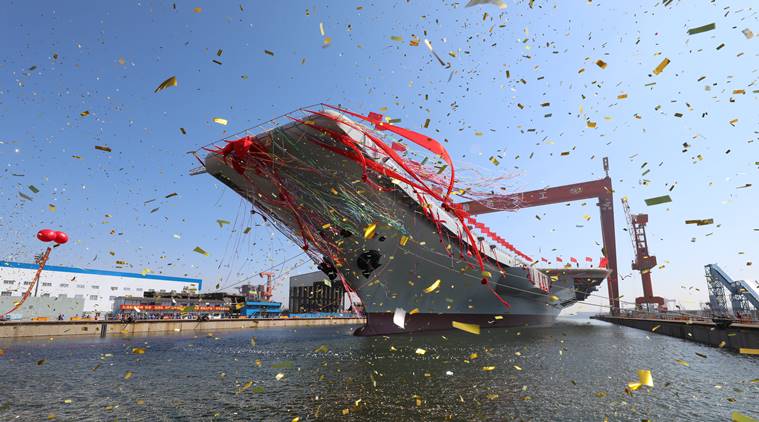 The newly-built aircraft carrier is transferred from dry dock into the water at a launch ceremony at a shipyard in Dalian in northeastern China’s Liaoning Province, Wednesday, April 26, 2017. (Xinhua via AP)
The newly-built aircraft carrier is transferred from dry dock into the water at a launch ceremony at a shipyard in Dalian in northeastern China’s Liaoning Province, Wednesday, April 26, 2017. (Xinhua via AP)
The carrier is built by state-owned Chinese Shipbuilding Industry Corp. The design of the carrier is based on the Soviet-era vessel Liaoning that China acquired from Ukraine six years ago and refitted according to its needs. It is 997 ft. in length. The carrier’s displacement is around 50,000 metric tons. The Type 001A is not a formidable opponent to the supercarriers in service in the US navy. The Chinese vessels have limitations like ski-jump decks, diesel propulsion and not enough overseas naval bases.
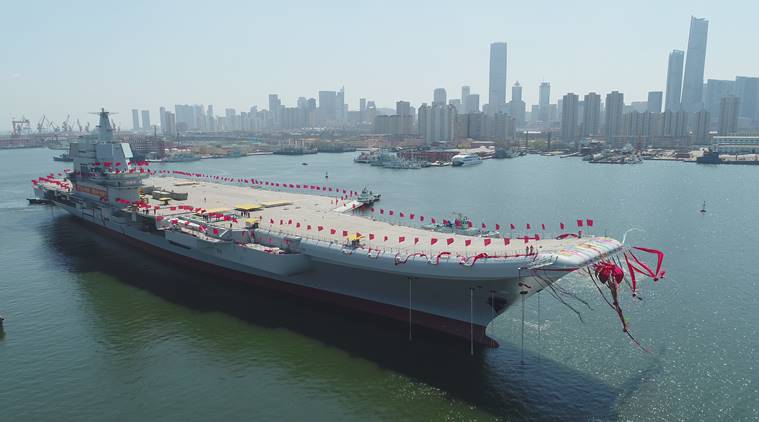 (Photo: Xinhua via AP)
(Photo: Xinhua via AP)
On the other hand, it is capable of accommodating more J-15 fighter jets than the Liaoning. It will be equipped with China’s S-band radar, the most advanced in Chinese inventory. It will also be installed with four batteries of HQ-10 short-range air-defence missiles.
It doesn’t have a steam catapult and that is expected in the carriers in the pipeline. The Type 001A’s shorter range means that the J-15 fighters will need to carry more fuel and the amount of ordnance the aircraft could carry will need to be reduced.
USS Gerald R Ford
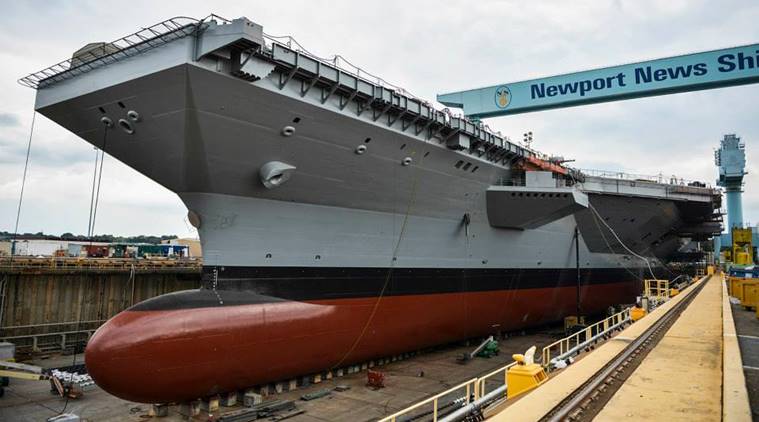 USS Gerald R Ford (Wikimedia Commons)
USS Gerald R Ford (Wikimedia Commons)
The USS Gerald R Ford is the most advanced warship ever built. It was constructed at a cost of nearly $13 billion. It is 1,106 ft. in length with a displacement of 1,01,605 metric tons. It has a height of 250 ft. and has 25 decks. Two A1B nuclear reactors power the carrier and it has a four shaft propulsion system. Its maximum speed can go up to 30 knots (56 km/h). Due to the nuclear-powered system, there is no limit on the range.
It has a 1,092 ft. long and 256 ft. wide flight deck and can carry at least 75 aircraft on board. It has Close-in weapon system (CIWS), RIM-116 Rolling Airframe Missiles, RIM-162 ESSMs as armaments. It can carry a crew of 4,550.
The US is currently building 2 and has 10 active aircraft carriers. Though it operates 19 vessels that qualify as aircraft carriers, it classifies only 10 in the category.
Russian Kuznetsov
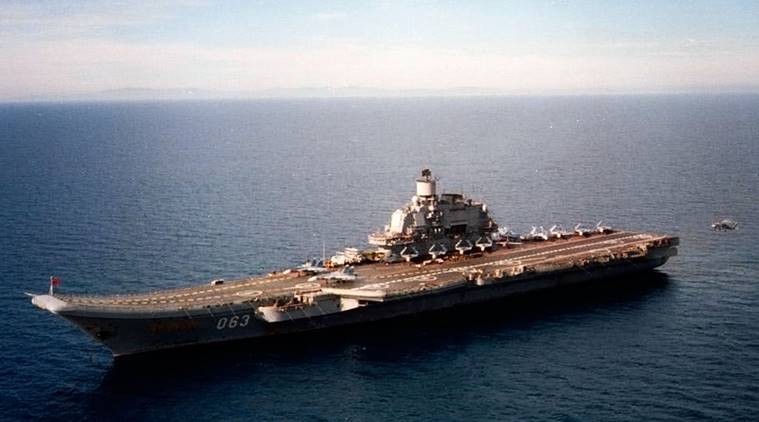 Russian aircraft carrier Kuznetsov (Wikimedia)
Russian aircraft carrier Kuznetsov (Wikimedia)
The Russian carrier is 990 ft. in length. It can carry 37 aircraft on board. It carries a crew of 3,452 on board. Its displacement is 59, 439 metric tons. Russia currently has one active carrier. It is powered by steam turbines. The vessel reaches a maximum speed of 29 knots (54 km/h). Its maximum range is 8,500 nautical miles (15,700 km) at 18 knots (33 km/h) and 3,800 nautical miles (7,000 km) at 29 knots.
It carries 12 P-700 Granit SS-N-19 Shipwreck anti-ship missiles and 192 surface to air missiles of 3K95 Kinzhal (SA-N-9 Gauntlet) class. It is also equipped with eight Kashtan CIWS mounts, six massive AK-630 AA guns and a UDAV-1 ASW rocket launcher. It can carry up to 32 fixed wing aircraft and up to two dozen helicopters. For take off, it has a Bow ski-jump and it also has an angled arrested landing flight deck.
Indian INS Vikramaditya
 INS Vikramaditya. (Photo Courtesy: Oleg Kuleshov)
INS Vikramaditya. (Photo Courtesy: Oleg Kuleshov)
The INS Vikramaditya is the sole active aircraft carrier in the Indian fleet currently with another in the production line. It is a modified Kiev-class carrier. It is 932 ft in length and can carry 18 aircraft on board. It carries a crew of 1,326 and has a displacement of 46,129 metric tons. The carrier is India’s mainstay naval deterrent in the Indian ocean, Bay of Bengal and the Arabian Sea.
It has 22 decks and is powered by six turbo alternators and six diesel alternators with a propulsion system of eight turbo-pressurised boilers, four shafts, four geared steam turbines and over 1,80,000 hp. It can reach speeds of up to 30 knots and has a maximum range of 25,000 km at 18 knots. It has an endurance period of 45 days after which it needs to dock for supplies, checks and maintenance.
China launches aircraft carrier in quest to be global naval power https://t.co/RLiQPEwwmP pic.twitter.com/snytywtQ2J
— Wall Street Journal (@WSJ) April 27, 2017
It is equipped with long-range air surveillance radars, LESORUB-E systems, Resistor-E radar complex, CCS MK II communication complex and Link II tactical data and system. It is armed with four AK-630 CIWS mounts, the advanced Barak 1 ex-INS Godavari, Barak 8 LR-SAM missiles.
It can carry up to three dozen aircraft depending on size and configuration. It can carry 26 MiG 29K multi-role fighter jets and 10 Kamov Ka-31 AEW&Cs. It can also carry Kamov Ka-28 ASW helicopters.
INS Vikramaditya has a 14-degree ski-jump for taking off. It also has three arrester gear (30m width) coupled with restraining gears.
UK’s carrier Queen Elizabeth
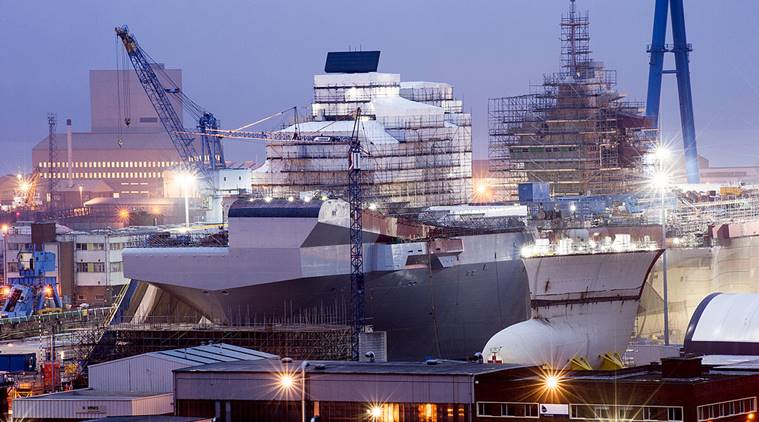 UK’s under-construction aircraft carrier Queen Elizabeth. (Source: Wikimedia)
UK’s under-construction aircraft carrier Queen Elizabeth. (Source: Wikimedia)
The carrier has a displacement of 65,000 metric tons and is 920 ft in length. It can carry up to 40 aircraft and a crew of 1,680. Two carriers of this class are being built.
The carrier has nine decks beneath the flight deck. Its hangar is covered by two decks. It is powered by two Rolls-Royce Marine Trent MT30 36MW gas turbines and four Wärtsilä 38 marine diesel engines. It can reach a maximum of 25 knots (46 km/h) and has a maximum range of 10,000 nautical miles (19,000 km).
It is equipped with an S1850 long range radar and 997 type Artisan 3D medium range radar sensor. It also has an ultra electronics series 2500 electro optical system and glide path camera. Its armed with three phalanx CIWS mounts and 30-mm DS30M Mk2 guns. It also carries miniguns.
It has a ski jump with a hangar deck and is also equipped two aircraft lifts to lift the aircraft from the hangar to the flight deck. It carries aircraft like F-35B, Chinook and also attack helicopters like the Apache AH64.
French carrier Charles de Gaulle
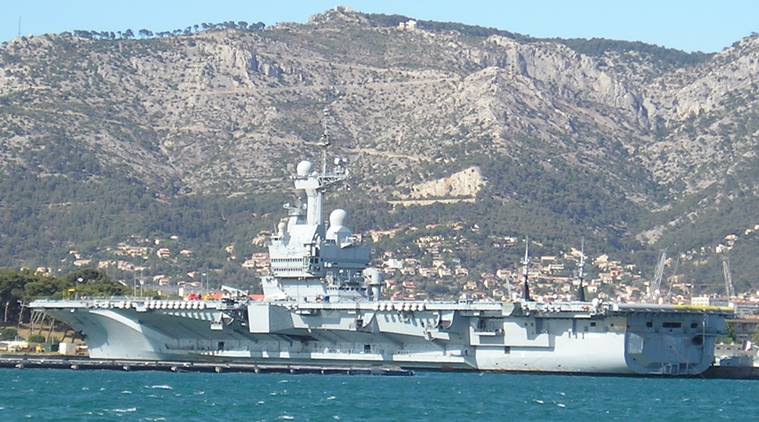 French aircraft carrier Charles de Gaulle. (Source: Wikimedia)
French aircraft carrier Charles de Gaulle. (Source: Wikimedia)
Charles de Gaulle is a unique type carrier and it doesn’t belong to a particular class of carriers. It is the only one carrier in service in the French Navy. It is 860 ft. long and has a crew of 2,571. It can carry at least 30 aircraft and has a displacement of 43,182 metric tons.
The carrier can reach speeds up to 27 knots (50 km/h) and has an unlimited range due to the powering system. Its endurance period is of 45 days and then it needs to restock.
It is equipped with DRBJ 11 B tridimensional air search radar, DRBV 26D air search radar and DRBV 15C low altitude air search radar. The offensive capabilities are enhanced with the Arabel target acquisition radar and it is one of the few carriers that have the capability for electronic warfare. It can also deploy decoys.
It has an ARBR-21 detector and ARBB-33 countermeasure suite. The interceptor module includes ARBG2 MAIGRET and four Sagaie decoy launchers. It also has SLAT (Système de lutte anti-torpille) torpedo countermeasures.
It is armed with four units of eight-cell A-43 Sylver launchers that launch MBDA Aster 15 SAMs. It also has two units of six cell Sadral launchers that launch Mistral short-range missile attacks. It has a formidable battery of eight Giat 20F2 20 mm cannons. It can carry aircraft like Rafale M, E-2c Hawkeye and SA365 Dauphin.







